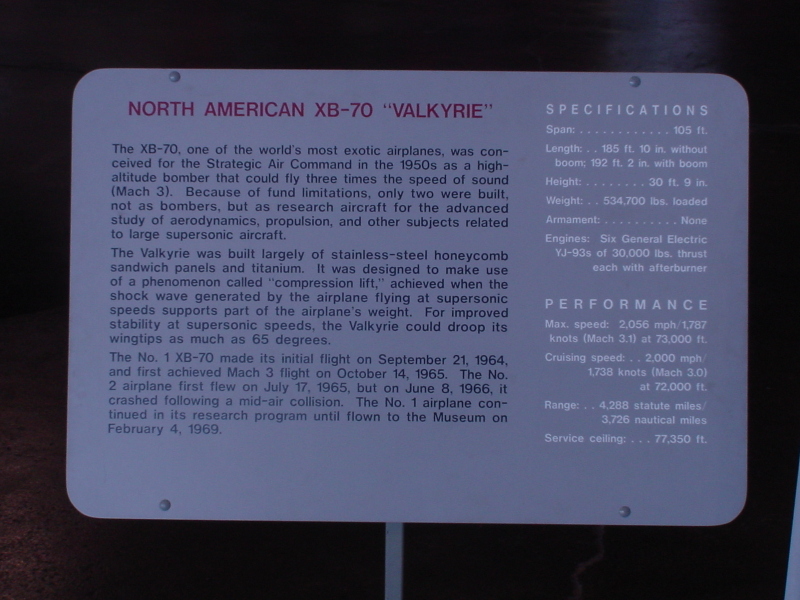| Prev |
heroicrelics.org Air Force Museum Site Index XB-70 Valkyrie Gallery |
Next |
dsc15422.jpg
The sign accompanying the plane. It reads
North American XB-70 "Valkyrie"
The XB-70, one of the world's most exotic airplanes, was conceived for the Strategic Air Command in the 1950s as a high-altitude bomber that could fly three times the speed of sound (Mach 3). Because of fund limitations, only two were built, not as bombers but as research aircraft for the advanced study of aerodynamics, propulsion, and other subjects related to large supersonic aircraft.
The Valkyrie was built largely of stainless-steel honeycomb sandwich panels and titanium. It was designed to make use of a phenomenon called "compression lift," achieved when the shock wave generated by the airplane flying at supersonic speeds supports part of the airplane's weight. For improved stability at supersonic speeds, the Valkyrie could droop its wingtips as much as 65 degrees.
The No. 1 XB-70 made its initial flight on September 21, 1964, and first achieved Mach 3 flight on October 14, 1965. The No. 2 airplane first flew on July 17, 1965, but on June 8, 1966, it crashed following a mid-air collision. The No. 1 airplane continued its research program until flown to the Museum on February 4, 1969.
Specifications Span: 103.8 ft Length: 185 ft. 10 in. without boom; 192 ft. 2 in. with boom Height: 30 ft. 9 in. Weight: 534,700 lbs loaded Armament: None Engines: Six General Electric
YJs of 30,000 lbs. thrust
each with afterburnerPerformance Max. Speed: 2,056 mph/1,787 knots (Mach 3.1) at 73,000 ft. Cruising Speed: 2,000 mph/
1,738 knots (Mach 3.0)
at 72,000 ft.Range: 4,288 statute miles/
3,726 nautical milesService Ceiling 77,350 ft.

| Time picture taken | Sat Oct 29 10:30:03 2005 |
| Location picture taken | Research and Development/Flight Test Gallery Air Force Museum Dayton, OH |
| Prev | XB-70 Valkyrie Gallery | Next |